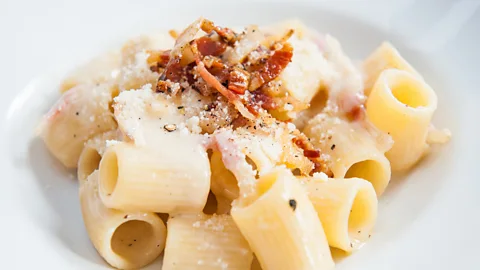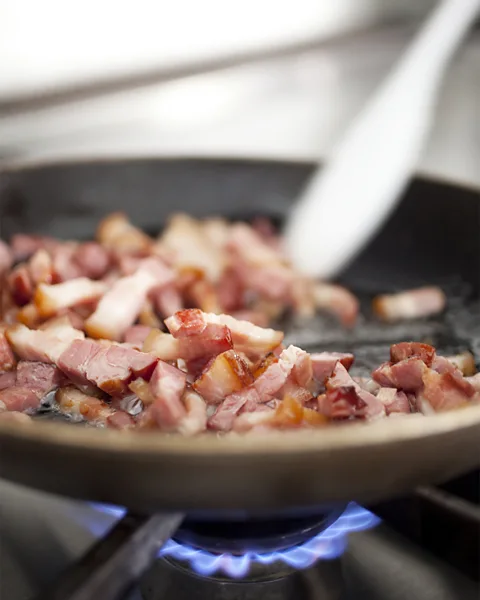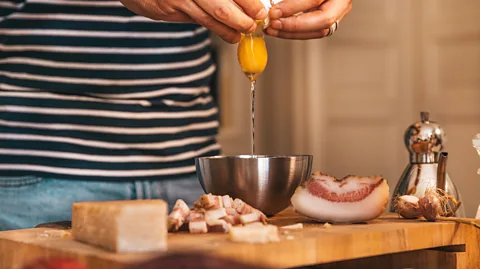The iconic pasta causing an Italian-American dispute
 sco Vignali/Getty Images
sco Vignali/Getty ImagesAn article claiming the American paternity of carbonara has caused an uproar in Italy and a spike in curiosity in the US. But where is the famous dish really from, and why do people care so much?
"Right now, we can't talk about anything else," my friend, a foreign affairs reporter in Rome, wrote to me. She wasn't talking about politics, but about pasta carbonara. A few minutes after her message, a New York writer friend told me he was being flown to Rome in a hurry to investigate the topic.
On 23 March, at the same time that Italy had put forward its cuisine as a candidate for Unesco's Intangible Heritage list, the Financial Times published an article in which Italian food expert Alberto Grandi claimed that carbonara was actually invented by Americans living in Italy just after World War Two. The claims in the article created an uproar across Italy. "A surrealist attack!", denounced the agricultural association Coldiretti, while the country weighed into a juicy debate on social media. Why is everyone so ionate about this? And who invented the real carbonara?
"It was a combination of Italian genius and American resources," explains Italian food author Eleonora Cozzella. She spent six years covering National Carbonara Day on 6 April, and ended up writing a book called The Perfect Carbonara that won a Gourmand World Cookbook Award in 2020. Its name is tongue-in-cheek, since perfection is elusive – and maybe even impossible – in the case of carbonara.
Cozzella interviewed the grandchildren of innkeepers who, in the late 1940s after World War Two, would feed American soldiers in the picturesque neighbourhood of Trastevere, just across the river Tiber in Rome. Soldiers were apparently asking for "spaghetti breakfast": eggs, bacon and pasta. And at the time, although the country was on its knees, Italians could buy military rations on the black market that included bacon from Americans and egg powder from the British.
The first carbonara recipe was published in the US in 1952. In Vittles and Vice: An Extraordinary Guide to What's Cooking on Chicago's Near North Side, author Patricia Bronté listed the Italian restaurant Armando's – owned by chefs Pietro Lencioni and Armando Lorenzini – among her favourite places. She added the recipe of its signature dish, carbonara.
Born in America from Italian parents, Lencioni grew up in Tuscany but moved back to the US before turning 18. His carbonara had typical Tuscan, not Roman, ingredients: tagliarini (wide egg tagliatelle from Lucca), mezzina (a Tuscan bacon), Parmigiano and eggs. Pietro's wanderings don't help in finding a clear-cut answer on the paternity of this pasta dish.
"No one has a trademark on the recipe," says Alessandro Pipero, chef of the Michelin-starred restaurant Pipero in Rome, who is considered one of the kings of carbonara. "Honestly, I don't care who invented it," he adds.
Instead, Pipero cares about other things, such as the "extreme browning" of the guanciale (cured pork cheek), a process in which he crisps the meat in a cast-iron pan. As the fat renders, he removes some of the molten liquid with a spoon. The lean part of the meat ultimately caramelises and becomes a sort of "popcorn guanciale": crunchy outside and tender inside.
His carbonara is very yellow in colour since he only uses egg yolks – one per 60g of pasta. He whips it together with pecorino cheese, pepper and some of the rendered fat from the guanciale, creating a savoury zabaione (an Italian custard). The final touch: he doesn't put the pasta with the egg mix back on the stove, but instead warms it up using the bain-marie technique (placing it over a heated water bath instead of direct heat), so that it doesn't "cook" but instead becomes creamy. He slowly adds some more liquid fat, adding the crispy guanciale at the very end. "That's important," he said. "If you add it before, it becomes soft." He serves it with pecorino and pepper.
 Lisa Romerein/Getty
Lisa Romerein/GettyIf we still want to split hairs about the origin of the dish, it should be noted that that the first Italian recipe for carbonara was published in August 1954 in La Cucina Italiana magazine. "And it is a strange one," says Cozzella. "It has parsley and even gruyere as cheese! It's as if they had heard about it but didn't know what they were writing about."
"This debate is ridiculous and dangerous," says Michele Fino, a law professor at the University of Gastronomic Sciences of Pollenzo, who considers it "old news". Grandi first wrote about carbonara's origins in his 2018 book Denominazione di origine inventata, and his thesis is ed by author Luca Cesari in his 2021 cookbook The Discovery of Pasta: A History in Ten Dishes. According to Fino, the debate is dangerous because, hidden between the pecorino and a piece of guanciale, or maybe deep inside the tubular rigatoni, might lurk a toxic kind of nationalism. "It is a sort of banal nationalism that runs through food," he says. "People consider it unimportant, but it creates a certain climate – we shouldn't ignore it."
Fino, who loves the Scientific Carbonara recipe by Dario Bressanini, because "the eggs stay runny", thinks that Italians are too "obsessed" with their origins as they build their identity around a set of indisputable truths about food – truths that are believed to be ancient, hence sacred. And some of these foundations are shaky. For instance, Italians can be draconian when it comes to carbonara and say that it is a sacrilege to add heavy cream. But less than 40 years ago, Gualtiero Marchesi, who is considered the "father of modern Italian cuisine", would add 250ml of heavy cream to 300g of spaghetti, an idea that sends shivers down the spine of Italian foodies today.
 Marco_Piunti/Getty Images
Marco_Piunti/Getty ImagesSo then, why do we care so much? For Italians, food is about care – and love. Cozzella, who favours Arcangelo Dandini's recipe for carbonara – which leaves the pepper on the side – reminded me that every time a loved one calls you around noon, the first question is invariably about food: "Did you eat">window._taboola = window._taboola || []; _taboola.push({ mode: 'alternating-thumbnails-a', container: 'taboola-below-article', placement: 'Below Article', target_type: 'mix' });
